Cell - the unit of life 1000+ MCQ with answer for DRDO
Thursday 9th of March 2023

Sharing is caring
1. The main organelle involved in modification and routing of newly synthesized proteins to their destinations is
A. chloroplast
B. mitochondria
C. lysosome
D. endoplasmic reticulum
Answer : D
A. chloroplast
B. mitochondria
C. lysosome
D. endoplasmic reticulum
Answer : D
2. Microtubules, motor proteins, and actin filaments are all part of the
A. mechanism of photosynthesis that occurs in chloroplasts.
B. rough ER in prokaryotic cells.
C. cytoskeleton of eukaryotic cells.
D. process that moves small molecules across cell membranes.
Answer : C
A. mechanism of photosynthesis that occurs in chloroplasts.
B. rough ER in prokaryotic cells.
C. cytoskeleton of eukaryotic cells.
D. process that moves small molecules across cell membranes.
Answer : C
3. Golgi apparatus is concerned with
A. excretion
B. secretion
C. ATP synthesis
D. RNA synthesis
Answer : A
A. excretion
B. secretion
C. ATP synthesis
D. RNA synthesis
Answer : A
4. Centrifugation of a cell results in the rupture of the cell membrane and the contents compacting into a pellets in the bottom of the centrifuge tube. Bathing this pellet with a glucose solution yields metabolic activity including the production of ATP. One of the contents of this pellet is most likely which of the following?
A. Cytosol
B. Mitochondria
C. Lysosomes
D. Golgi bodies
Answer : B
A. Cytosol
B. Mitochondria
C. Lysosomes
D. Golgi bodies
Answer : B
5. In the given figure of animal cell, one orginelle is marked as A. Select the correct identification and function of the organelle A from the given option.
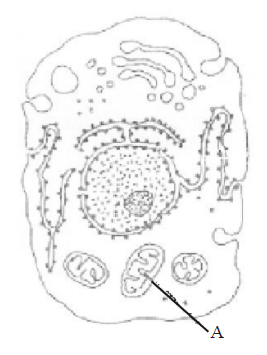
A. Endoplasmic reticulum Synthesis of lipids.
B. Mitochondria Produce cellular energy in the form of ATP.
C. Golgi body Provides packaging material.
D. Lysosomes Secrete hydrolytic enzymes.
Answer : B

A. Endoplasmic reticulum Synthesis of lipids.
B. Mitochondria Produce cellular energy in the form of ATP.
C. Golgi body Provides packaging material.
D. Lysosomes Secrete hydrolytic enzymes.
Answer : B
6. Consider the following statements and choose the correct statement.
A. (i) and (iii)
B. (ii) and (iv)
C. (iii) and (iv)
D. (ii) and (iii)
Answer : D
- The endomembrane system includes mitochondria, chloroplast and peroxisomes.
- Smooth endoplasmic reticulum is the major site for synthesis of lipid.
- Rough endoplasmic reticulum is actively involved in protein synthesis.
- Mitochondrial matrix possesses single circular DNA, a few RNA and 80S ribosomes. Of the above statements.
A. (i) and (iii)
B. (ii) and (iv)
C. (iii) and (iv)
D. (ii) and (iii)
Answer : D
7. Protein synthesis in an animal cell occurs
A. on ribosomes present in cytoplasm as well as in mitochondria.
B. on ribosomes present in the nucleolus as well as in cytoplasm.
C. only on ribosomes attached to the nuclears envelope and endoplasmic reticulum.
D. only on the ribosomes present in cytosol.
Answer : A
A. on ribosomes present in cytoplasm as well as in mitochondria.
B. on ribosomes present in the nucleolus as well as in cytoplasm.
C. only on ribosomes attached to the nuclears envelope and endoplasmic reticulum.
D. only on the ribosomes present in cytosol.
Answer : A
8. Statement 1: Centrosomes and centrioles are related to each other.
Statement 2: Centrosome usually contains two cylindrical structures called centrioles.
A. Both statements -1 and statement - 2 are true and statement - 2 is the correct explanation of statement - 1.
B. Both statements -1 and statement - 2 are true but statement - 2 is not the correct explanation of statement - 1.
C. Statement -1 is true and statement - 2 is false.
D. Statement -1 is false and statement - 2 is true.
Answer : A
Statement 2: Centrosome usually contains two cylindrical structures called centrioles.
A. Both statements -1 and statement - 2 are true and statement - 2 is the correct explanation of statement - 1.
B. Both statements -1 and statement - 2 are true but statement - 2 is not the correct explanation of statement - 1.
C. Statement -1 is true and statement - 2 is false.
D. Statement -1 is false and statement - 2 is true.
Answer : A
9. Study the following statements on cilium or flagellum and answer the question.
Which of the above statements are correct?
A. (i) and (ii)
B. (i), (ii), (iii) and (iv)
C. (i) and (iv)
D. (ii) and (iii)
Answer : B
- Cilium / Flagellum contains an outer ring of nine doublet microtubules surrounding two singlet microtubules.
- Cilia are smaller which work like oars, causing the movement of either the cells or surrounding fluid.
- Flagella are comparatively longer and responsible for cell movement.
- Cilium and flagellum are covered with plasma membrane.
Which of the above statements are correct?
A. (i) and (ii)
B. (i), (ii), (iii) and (iv)
C. (i) and (iv)
D. (ii) and (iii)
Answer : B
10. Which of the following statements are correct?
A. Na+/K+ pump is an example of active transport.
B. In plant cells lipid like steroidal hormones are synthesized in SER.
C. In plant cells, the vacuoles can occupy up to 10% of the volume of the cell.
D. Chlorophyll and leucoplast are responsible for trapping light energy essential for photosynthesis.
Answer : A
A. Na+/K+ pump is an example of active transport.
B. In plant cells lipid like steroidal hormones are synthesized in SER.
C. In plant cells, the vacuoles can occupy up to 10% of the volume of the cell.
D. Chlorophyll and leucoplast are responsible for trapping light energy essential for photosynthesis.
Answer : A
11. Which of the following statements are incorrect ?
A. (i) and (iii)
B. (iii) and (iv)
C. (ii) and (iv)
D. (i) and (iv)
Answer : A
- Plant cells have centrioles which are absent in almost all animal cells.
- Ribosomes are the site of protein synthesis.
- The middle lamella is a layer mainly of calcium carbonate which holds the different neighbouring cells together.
- In animal cell, steroidal hormones are synthesized by smooth endoplasmic reticulum. Of the above statements
A. (i) and (iii)
B. (iii) and (iv)
C. (ii) and (iv)
D. (i) and (iv)
Answer : A
12. Which one of the following organelle given below is correctly matched with its function ?
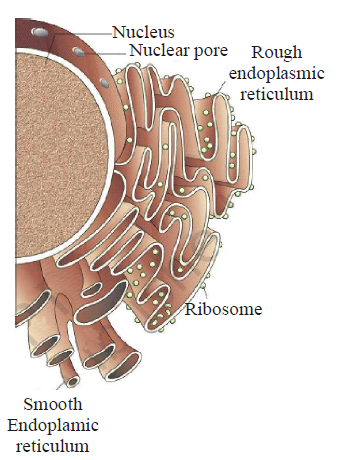
A. Golgi apparatus Protein synthesis
B. Golgi apparatus Formation of glycolipids
C. Rough endoplasmic reticulum Protein synthesis
D. Rough endoplasmic reticulum Formation of glycoproteins
Answer : C

A. Golgi apparatus Protein synthesis
B. Golgi apparatus Formation of glycolipids
C. Rough endoplasmic reticulum Protein synthesis
D. Rough endoplasmic reticulum Formation of glycoproteins
Answer : C
13. Difference between the prokaryotic and eukaryotic cells in having
A. cell wall
B. nuclear membrane
C. ribosome
D. none of these
Answer : B
A. cell wall
B. nuclear membrane
C. ribosome
D. none of these
Answer : B
14. Match column-I with column-II and choose the correct option.
A. A IV; B III; C I; D II
B. A II; B III; C IV; D I
C. A IV; B II; C III; D I
D. A I; B III; C II; D IV
Answer : A
| Column-I | Column-II |
|---|---|
| A. Tonoplast | I. Contain digestive enzyme |
| B. Contractile vacuole | II. Store metabolic gases |
| C. Food vacuole | III. Excretion |
| D. Air vacuole | IV. Transport of ions in plants |
A. A IV; B III; C I; D II
B. A II; B III; C IV; D I
C. A IV; B II; C III; D I
D. A I; B III; C II; D IV
Answer : A
15. Cell sap is a
A. living content of cytoplasm.
B. nonliving content of cytoplasm.
C. nonliving content of vacuole.
D. living content of vacuole.
Answer : C
A. living content of cytoplasm.
B. nonliving content of cytoplasm.
C. nonliving content of vacuole.
D. living content of vacuole.
Answer : C
16. Select the correct match of the types of neuron present in column I with its location given in column II.
A. A - (i), B - (ii), C - (iii), D - (iv)
B. A - (iii), B - (i), C - (ii), D - (iv)
C. A - (iii), B - (i), C - (iv), D - (ii)
D. A - (i), B - (iv), C - (iii), D - (ii)
Answer : B
| Column I | Column II |
|---|---|
| A. Centrioles | (i) Non-membrane bound organelle which helps in cell division |
| B. Fimbriae | (ii) Special structure of bacteria which help them to attach with rocks in stream and also to host tissue |
| C. Endomembrane | (iii) Includes those organelles system whose functions are coordinated |
| D. Mitochondria | (iv) Divide by fission and site of aerobic respiration |
A. A - (i), B - (ii), C - (iii), D - (iv)
B. A - (iii), B - (i), C - (ii), D - (iv)
C. A - (iii), B - (i), C - (iv), D - (ii)
D. A - (i), B - (iv), C - (iii), D - (ii)
Answer : B
17. Read the statements given below with regard to the functions performed by Golgi apparatus ?
Which of the following is the correct answer ?
A. (i) is wrong but (ii) and (iii) are correct
B. (ii) is wrong but (i) and (iii) are correct
C. (ii) and (iii) are wrong but (i) is correct
D. All are correct.
Answer : D
- Transport and chemically modify the materials contained within it.
- Performs the function of packaging materials.
- Important site of formation of glycoproteins and glycolipids.
Which of the following is the correct answer ?
A. (i) is wrong but (ii) and (iii) are correct
B. (ii) is wrong but (i) and (iii) are correct
C. (ii) and (iii) are wrong but (i) is correct
D. All are correct.
Answer : D
18. Which of the following pair lack the unit membrane?
A. Nucleus and E.R.
B. Mitochondria and chloroplast
C. Ribosome and nucleolus
D. Golgi body and lysosome
Answer : C
A. Nucleus and E.R.
B. Mitochondria and chloroplast
C. Ribosome and nucleolus
D. Golgi body and lysosome
Answer : C
19. 8.A student was given cell samples (A and B) to identify parts which are highlighted. He observed the samples under the microscope and list down the function of the part of cell sample. The information collected by the student is listed in the table below, on the basis of which the student infers that the samples contain the organelles.
Identify the part highlighted in the sample A and B and explain why they were called as semi-autonomous organelles?
A. Sample A - Mitochondria, Sample B - Chloroplast; because both the organelles are double membrane bound structure.
B. Sample A- Mitochondria, Sample B - Chloroplast; because they both are capable of synthesis of their own proteins only.
C. Sample A - Mitochondria, Sample B - Chloroplast; because they are capable of synthesis of their own proteins and contain their own DNA.
D. Sample A- Mitochondria, Sample B - Chloroplast; because they contain their own DNA to transfer the genetic information from one generation to another.
Answer : C
| Sample A | Sample B |
|---|---|
| Make energy available for cellular metabolism | Generates ATP and synthes izes s ugar |
| Absent in cell that carry oxygen throughout the body | Present in plant cell |
| Called the energy currency of cell | Source o f all the food energy |
Identify the part highlighted in the sample A and B and explain why they were called as semi-autonomous organelles?
A. Sample A - Mitochondria, Sample B - Chloroplast; because both the organelles are double membrane bound structure.
B. Sample A- Mitochondria, Sample B - Chloroplast; because they both are capable of synthesis of their own proteins only.
C. Sample A - Mitochondria, Sample B - Chloroplast; because they are capable of synthesis of their own proteins and contain their own DNA.
D. Sample A- Mitochondria, Sample B - Chloroplast; because they contain their own DNA to transfer the genetic information from one generation to another.
Answer : C
20. Lysosomes contain
A. carbohydrates
B. hormones
C. nucleic acids
D. hydrolases.
Answer : D
A. carbohydrates
B. hormones
C. nucleic acids
D. hydrolases.
Answer : D
21. Which of the following terms is not correctly matched with its feature?
A. Osmosis Movement of water by diffusion.
B. Nucleoplasm Site of active synthesis of ribosomal RNA.
C. Mesosome Infolding of cell membrane and characteristics of eukaryotes.
D. Pili Elongated tubular surface structures (made of special protein) of bacteria.
Answer : C
A. Osmosis Movement of water by diffusion.
B. Nucleoplasm Site of active synthesis of ribosomal RNA.
C. Mesosome Infolding of cell membrane and characteristics of eukaryotes.
D. Pili Elongated tubular surface structures (made of special protein) of bacteria.
Answer : C
22. Match column-I with column-II and select the correct option.
A. A - IV, B - V, C - I, D - II
B. A - I, B - II, C - IV, D - III
C. A - IV, B - I, C - II, D - III
D. A - I, B - II, C - III, D - IV
Answer : A
| Column - I | Column - II |
|---|---|
| A. Golgi apparatus | I. Storage |
| B. Mitochondria | II. Photosynthesis |
| C. Vacuoles | III. Transport |
| D. Grana | IV. Secretion |
| .. | V. Respiration |
A. A - IV, B - V, C - I, D - II
B. A - I, B - II, C - IV, D - III
C. A - IV, B - I, C - II, D - III
D. A - I, B - II, C - III, D - IV
Answer : A
23. Integral proteins of cell membrane occur on/in
A. inner surfaces
B. outer surfaces
C. phospholipid matrix
D. inner and outer surfaces
Answer : D
A. inner surfaces
B. outer surfaces
C. phospholipid matrix
D. inner and outer surfaces
Answer : D
24. Match column-I (cell organelle) with column-II membrane and select the correct option from the codes given below.
A. A - I, B - II, C - III
B. A - III, B - I, C - II
C. A - III, B - II, C - I
D. A - II, B - III, C - I
Answer : C
| Column-I | Column-II |
|---|---|
| A. Mitochondria | I. Without membrane |
| B. Lysosomes | II. Single membrane |
| C. Ribosomes | III. Double membrane |
A. A - I, B - II, C - III
B. A - III, B - I, C - II
C. A - III, B - II, C - I
D. A - II, B - III, C - I
Answer : C
25. Which of the following cell organelles were discovered after the introduction of electron microscope?
A. Mitochondria
B. Endoplasmic reticulum
C. Ribosomes
D. Both (b) and (c)
Answer : D
A. Mitochondria
B. Endoplasmic reticulum
C. Ribosomes
D. Both (b) and (c)
Answer : D
26. Which of the following is absent in prokaryotes?
A. DNA
B. RNA
C. Plasma membrane
D. Mitochondria
Answer : D
A. DNA
B. RNA
C. Plasma membrane
D. Mitochondria
Answer : D
27. Function of RER is
A. autolysis
B. protein synthesis
C. lipid synthesis
D. carbohydrate synthesis
Answer : B
A. autolysis
B. protein synthesis
C. lipid synthesis
D. carbohydrate synthesis
Answer : B
28. The best way to identify a cell as either prokaryotic or eukaryotic is to determine whether
A. it came from a single-celled or multicellular organism.
B. it has a nucleus.
C. it has a plasma membrane.
D. it has cytosol.
Answer : A
A. it came from a single-celled or multicellular organism.
B. it has a nucleus.
C. it has a plasma membrane.
D. it has cytosol.
Answer : A
29. In which method of transport, plasma membrane does not require carrier molecule?
A. Active transport
B. Facilitated diffusion
C. Simple diffusion
D. Na+ K+ pump
Answer : C
A. Active transport
C. Simple diffusion
D. Na+ K+ pump
Answer : C
30. You are asked to examine a cell using a powerful light microscope. The image you see has a clearly defined nucleus and mitochondria. It also has a large central vacuole and chloroplasts. From what group of organisms did this cell most likely come?
A. Bacteria
B. Protists
C. Fungi
D. Plants
Answer : D
A. Bacteria
B. Protists
C. Fungi
D. Plants
Answer : D
31. Identify the cell organelle given below. Which is an important site of formation of glyeoproteins & glycolipids
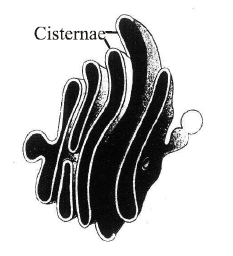
A. Rough endoplasmic reticulum
B. Smooth endoplasmic reticulum
C. Golgi body
D. mitochondria
Answer : C

A. Rough endoplasmic reticulum
B. Smooth endoplasmic reticulum
C. Golgi body
D. mitochondria
Answer : C
32. The following diagram shows some of the missing structures in a plant cell marked as A, B, C, D E. Choose the option with their correct names.
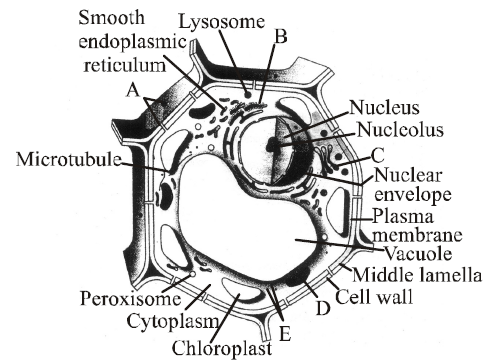
A. A - Plasmodesmata, B - Rough endoplasmic reticulum, C - Golgi apparatus, D - Mitochondrion, E - Ribosomes
B. A - Desmosome, B - Rough endoplasmic reticulum, C - Golgi apparatus, D - Mitochondrion, E - Ribosomes
C. A - Plasmodesmata, B - Smooth endoplasmic reticulum, C - Golgi apparatus, D - Mitochondrion, E - Ribosomes
D. A - Tight junction, B - Rough endoplasmic reticulum, C - Golgi apparatus, D - Mitochondrion, E -Ribosomes
Answer : A

A. A - Plasmodesmata, B - Rough endoplasmic reticulum, C - Golgi apparatus, D - Mitochondrion, E - Ribosomes
B. A - Desmosome, B - Rough endoplasmic reticulum, C - Golgi apparatus, D - Mitochondrion, E - Ribosomes
C. A - Plasmodesmata, B - Smooth endoplasmic reticulum, C - Golgi apparatus, D - Mitochondrion, E - Ribosomes
D. A - Tight junction, B - Rough endoplasmic reticulum, C - Golgi apparatus, D - Mitochondrion, E -Ribosomes
Answer : A
33. 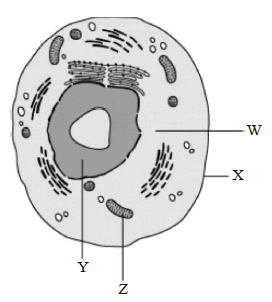
Which cellular structure helps in transferring genetic information from one generation to another?
A. W
B. X
C. Y
D. Z
Answer : C

Which cellular structure helps in transferring genetic information from one generation to another?
A. W
B. X
C. Y
D. Z
Answer : C
34. Both the membranes of mitochondrion are
A. structurally different but functionally similar.
B. structurally as well as functionally different.
C. structurally similar but functionally different.
D. structurally different but functionally similar.
Answer : B
A. structurally different but functionally similar.
B. structurally as well as functionally different.
C. structurally similar but functionally different.
D. structurally different but functionally similar.
Answer : B
35. Match column-I with column-II and select the correct option.
A. A III, B II, C IV, D I
B. A II, B III, C IV, D I
C. A I, B III, C II, D IV
D. A IV, B II, C III, D I
Answer : A
| Column - I | Column - II |
|---|---|
| A. RER | I. Intracellular and extracellular digestion |
| B. Cell wall | II. Provide structural support to the cell |
| C. Flagella | III. Protein synthesis and secretion |
| D. Lysosomes | IV Responsible for cell movement |
A. A III, B II, C IV, D I
B. A II, B III, C IV, D I
C. A I, B III, C II, D IV
D. A IV, B II, C III, D I
Answer : A
36. Golgi apparatus is absent in
A. higher plants
B. yeast
C. bacteria and blue-green algae
D. None of the above
Answer : C
A. higher plants
B. yeast
C. bacteria and blue-green algae
D. None of the above
Answer : C
37. The membrane of the erythrocytes has approximately ___% of proteins and ___% lipids.
A. 42, 50
B. 52, 40
C. 50, 50
D. 60, 40
Answer : B
A. 42, 50
B. 52, 40
C. 50, 50
D. 60, 40
Answer : B
38. Which of the following organelles is directly connected to the outer membrane of the nucleus in a eukaryotic cell?
A. Mitochondrion
B. Lysosome
C. Golgi apparatus
D. Endoplasmic reticulum
Answer : D
A. Mitochondrion
B. Lysosome
C. Golgi apparatus
D. Endoplasmic reticulum
Answer : D
39. Match column-I with column-II and choose the correct option.
A. A III; B IV; C II; D I
B. A IV; B III; C II; D I
C. A I; B II; C III; D IV
D. A IV; B III; C I ; D II
Answer : A
| Column-I | Column-II |
|---|---|
| (Chromosome) | (Position of Centromere) |
| A. Metacentric | I. At the tip |
| B. Submetacentric | II. Almost near the tip |
| C. Acrocentric | III. At the middle |
| D. Telocentric | IV. Slightly away from the middle |
A. A III; B IV; C II; D I
B. A IV; B III; C II; D I
C. A I; B II; C III; D IV
D. A IV; B III; C I ; D II
Answer : A
40. Which of the following option correctly match A, B, C, and D indicated in the given sectional view of chloroplasts.

A. A - Thylakoid, B-Stromal lamella, C - Stroma, D - Granum
B. A - Granum, B - Thylakoid, C - Stromal lamella, D - Stroma
C. A - Thylakoid, B - Granum, C - Stromal lamella, D - Stroma
D. A - Granum, B - Thylakoid, C - Stroma, D - Stromal lamella
Answer : B

A. A - Thylakoid, B-Stromal lamella, C - Stroma, D - Granum
B. A - Granum, B - Thylakoid, C - Stromal lamella, D - Stroma
C. A - Thylakoid, B - Granum, C - Stromal lamella, D - Stroma
D. A - Granum, B - Thylakoid, C - Stroma, D - Stromal lamella
Answer : B
41. Match the items given in column-I with their role given in column-II and choose the correct option.
A. A V; B III; C I; D IV; E II
B. A V; B III: C II; D IV; E I
C. A II; B III; C I; D IV; E V
D. A III; B IV; C I; D V; E II
Answer : A
| Column-I | Column-II |
|---|---|
| A. SER | I. Increase the surface area |
| B. Golgi apparatus | II. Store oils or fats |
| C. Cristae | III. Excretion |
| D. Peroxisome | IV. Photorespiration |
| E. Elaioplasts | V. Synthesis of lipid |
A. A V; B III; C I; D IV; E II
B. A V; B III: C II; D IV; E I
C. A II; B III; C I; D IV; E V
D. A III; B IV; C I; D V; E II
Answer : A
42. Which of the following statements is/are correct ?
A. (ii), (iii) & (iv)
B. (i) only
C. (ii) only
D. (iii) only
Answer : A
- The endomembrane system includes plasma membrane, ER, Golgi complex, lysosomes and vacuoles.
- ER helps in the transport of substances, synthesis of proteins, lipoproteins and glycogen.
- Ribosomes are involved in protein synthesis.
- Mitochondria help in oxidative phosphorylation and generation of ATP.
A. (ii), (iii) & (iv)
B. (i) only
C. (ii) only
D. (iii) only
Answer : A
43. Active transport across biomembrane involves
A. production of ATP
B. requirement of energy
C. production of toxin
D. release of energy
Answer : B
A. production of ATP
B. requirement of energy
C. production of toxin
D. release of energy
Answer : B
44. Which of the following statements are correct ?
A. (iii) and (iv)
B. (i) and (ii)
C. (ii) and (iii)
D. (i) and (iv)
Answer : A
- In prokaryotic cells, a special membranous structure formed by the extension of the plasma membrane into the cell is known as polysome.
- The smooth endoplasmic reticulum is the major site for synthesis of glycoproteins.
- RuBisCO is the most abundant protein in the whole biosphere.
- Mitochondria, chloroplasts and peroxisomes are not considered as part of endomembrane system. Of the above statements
A. (iii) and (iv)
B. (i) and (ii)
C. (ii) and (iii)
D. (i) and (iv)
Answer : A
45. Identify the components labelled A, B, C and D in the given section of cilia/flagella showing different parts. Choose the option which shows the correct labelling of parts.
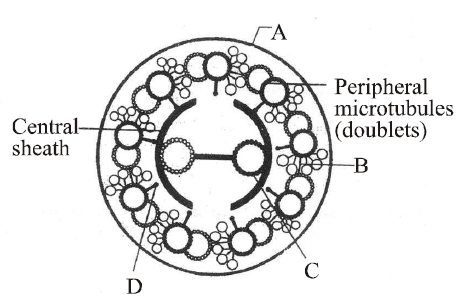
A. A Plasma membrane, B Interdoublet bridge, C Central microtubule, D Radial spoke
B. A Plasma membrane, B Arm, C Central microtubule, D Radial spoke
C. A Plasma membrane, B Interdoublet bridge, C Hub, D Radial spoke
D. A Plasma membrane, B Interdoublet bridge, C Hub, D Arm
Answer : A

A. A Plasma membrane, B Interdoublet bridge, C Central microtubule, D Radial spoke
B. A Plasma membrane, B Arm, C Central microtubule, D Radial spoke
C. A Plasma membrane, B Interdoublet bridge, C Hub, D Radial spoke
D. A Plasma membrane, B Interdoublet bridge, C Hub, D Arm
Answer : A
46. The following diagram represents a structure chromosome.
Identify the structures marked as A, B and C.
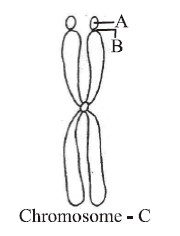
A. A - Satellite, B - Primary constriction, C - Acrocentric
B. A - Satellite, B - Secondary constriction, C - Metacentric
C. A - Satellite, B - Centromere, C - Telocentric
D. A - Satellite, B - Centromere, C - Submetacentric
Answer : B
Identify the structures marked as A, B and C.

A. A - Satellite, B - Primary constriction, C - Acrocentric
B. A - Satellite, B - Secondary constriction, C - Metacentric
C. A - Satellite, B - Centromere, C - Telocentric
D. A - Satellite, B - Centromere, C - Submetacentric
Answer : B
47. Which of the following statement of a bacterial cell is/are correct?
A. (i), (ii), (iii)
B. All of the above
C. (ii) & (iv)
D. None of the above
Answer : A
- Mesosome is formed by the extensions of plasma membrane into the cell.
- The pili are elongated tubular structures made up of a protein.
- Flagellum is composed of filament, hook and basal body.
- Ribosomes are about 30 nm by 50 nm in size.
A. (i), (ii), (iii)
B. All of the above
C. (ii) & (iv)
D. None of the above
Answer : A
48. Which one of the following pairs is not correctly matched?
A. Cristae The tubular structure formed by the folding of the inner membrane of the mitochondrion.
B. Plasmodesmata The membrane surrounding the vacuole in plants.
C. Grana Membrane bound discs in chloroplasts that contain chlorophylls and carotenoids.
D. Middle lamella Layer between adjacent cells walls in plants derived from cell plate.
Answer : B
A. Cristae The tubular structure formed by the folding of the inner membrane of the mitochondrion.
B. Plasmodesmata The membrane surrounding the vacuole in plants.
C. Grana Membrane bound discs in chloroplasts that contain chlorophylls and carotenoids.
D. Middle lamella Layer between adjacent cells walls in plants derived from cell plate.
Answer : B
49. Who proposed the theory that Cells arise only from the pre-existing cells?
A. Mohl
B. Virchow
C. Haeckel
D. Brown
Answer : B
A. Mohl
B. Virchow
C. Haeckel
D. Brown
Answer : B
50. Nucleolus is
A. rounded structure found in cytoplasm near nucleus.
B. rounded structure inside nucleus and having rRNA.
C. rod-shaped structure in cytoplasm near the nucleus.
D. none of the above.
Answer : B
A. rounded structure found in cytoplasm near nucleus.
B. rounded structure inside nucleus and having rRNA.
C. rod-shaped structure in cytoplasm near the nucleus.
D. none of the above.
Answer : B
Sharing is caring
Related Post
Radiologic Examination 1000+ MCQ with answer for SSC Stenographer
LIC AAO - Antonyms 1000+ MCQ [Solved] PDF Download
1000+ Anatomy of flowering plant MCQ for UPSC IES [Solved]
1000+ Antonyms Multiple Choice Question Answer [Solved]
Internal Combustion MCQ Solved Paper for SSC JHT
1000+ Microsoft Word Multiple Choice Question Answer [Solved]